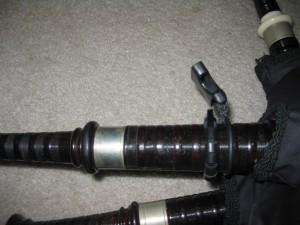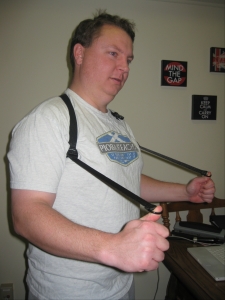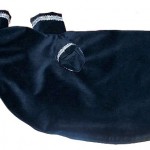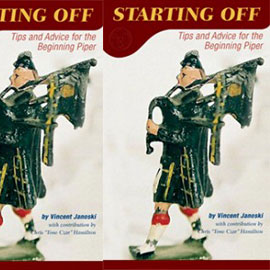Review: The Bagpipe Harness
This is a guest post by Nathan Wahlgren, the Keydet Piper.
I had a chance this weekend to try the Bagpipe Harness, kindly sent to me by the designer Colin Roddick.
One line summary: the product is pretty good, but I don’t recommend a piper relying on it for every piping situation. A detailed review follows.
Background
The Harness is designed to combat the problem of the slipping pipe bag, which is pretty annoying. If my bag slips I find that I’ll be squeezing it with my forearm instead of my elbow, making the instrument much less comfortable to play. Physically it can seriously affect both blowing and top hand technique, and mentally I can’t concentrate on the music if I’m worried about the instrument.
Enter Colin Roddick. He designed the Bagpipe Harness to alleviate this problem, physically connecting you to your pipes and supporting the weight of the pipes from above instead of below.
The harness itself is made of two webbed straps that tighten around your shoulders. The harness he sent me is the new “crossback” design (an improvement over the original model that attached to the waistline of your kilt), and getting into it is as easy as putting on a coat. A plastic clip on the bag shoulder clips to a rubber O-ring that slides over the stock of the bass drone. A clamp ring attaches to the drone stock above the O-ring to prevent it from sliding around. The clip allows the pipes to be disconnected without the piper having to wriggle out of the harness.
First Impressions
The harness is well made. The materials and craftsmanship are solid, and without much effort the harness should last for a good long while. The directions are thorough and detailed, with plenty of diagrams, so installing and setting up the harness is pretty straightforward and only takes a few minutes. After playing for a short time and making some minor adjustments to the fit, I had it pretty well set up.
In Action
I tried the bagpipe harness for about half an hour during my regular practice session, as well as for about 45 minutes at band practice.
While playing, I could definitely feel the straps under my arms. It’s not exactly uncomfortable, but it’s definitely noticeable. I noticed at first that the pipes didn’t rest where they naturally did without the harness; the instrument was still playable, but in a slightly different position than I was used to. After some more adjustments, I think I found the sweet spot and the pipes rested more comfortably.
I noticed almost immediately that my top hand was more relaxed than usual, having been relieved of the strain I hadn’t realized was there. With the harness supporting the bag, my fingers were much more relaxed and moved much more freely.
During breaks between tunes, the mobility of the pipes is severely limited. The bag rests in a way makes striking in a bit different, but it’s not awkward and after a few practice starts I had figured it out.
What I Like
- The harness does exactly what it is supposed to do. It took the strain off my left arm, and I could feel my top hand execution moving more freely than before.
- Once you find the sweet spot, those pipes aren’t moving. They stayed where I put them and were very comfortable to play.
What I Don’t Like
- The clamp ring that secures the harness to the drone stock is built with a zip tie, so once it’s been fastened to the pipes it can’t be removed without destroying it. The ring has to stay on the pipes even when you’re not using the harness.
- It takes some tinkering to get the harness adjusted properly, a process that must be repeated every time you put the harness on. Not hard, but it can be a little tedious to get everything set just right.
- You never forget that you’re wearing the harness. It’s not uncomfortable or obstructive, but it’s clearly there.
- Clicking into or out of the harness is not exactly easy. It took a few tries and some wiggling to get it set; I wouldn’t love to do that at the line of a band contest.
- When not using the harness, I could sometimes feel the clamp ring resting on my collarbone. Not painful, but definitely unpleasant.
Overall Assessment
Even though my “Don’t Likes” outnumber my “Likes,” I’ll give the Bagpipe Harness a thumbs up. It’s a little tricky to get it adjusted properly, but once it is this one is a winner.
However I would caution against relying on the harness for all of your piping. Personally, I won’t use my harness in a competition (solo or band) because I feel strongly that being able to control the bag is something that EVERY piper should be able to do. I would, however, recommend using the harness in certain cases (like long parades, or a performances requiring an unusually long playing time), and only if it can be discreetly concealed under clothing.
Over the years I’ve figured out a pretty good balance of bag size, blowpipe length, reed strength, clothing, and practice that allows me to control the bag and minimize slipping, and I suggest that pipers exhaust these solutions before relying on a device like the harness.
-
Oscar Stern
-
Oscar Stern
-
Oscar Stern
-
Oscar Stern
-
Oscar Stern
 Pipehacker
Pipehacker












